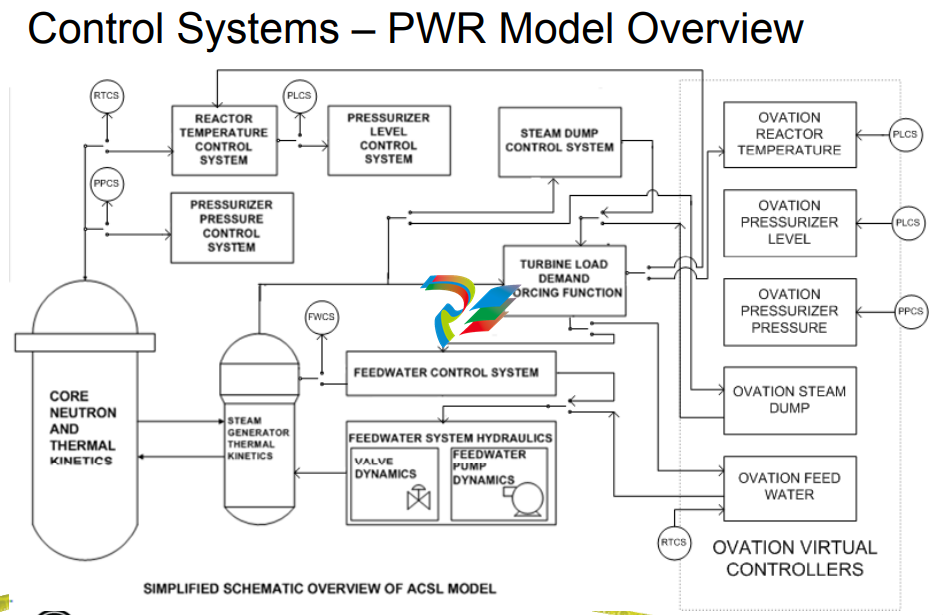
EMERSONWestinghouse Nuclear Automation
– Steam Dump or Steam Bypass – Reactor Pressure Regulation
– Feed System Feed System
– Steam System
– NSSS (core)
● Evaluation response over the full range of operation and
operational transient conditions
– Normal Operation
– Contingency Operations
● Provides high confidence set of initial tunings
● Pr
ovides
a basis for v
alidati
on
of desig
n
Feed Water Control Design Overview
- Example
● S/G Model Description Example
– Nodes of S/G Model
Feed Water Control Design Overview Example
Nodes of S/G Model
– Primary side tubes
– Secondary side tube bundle area (inside of wrapper)
– Riser section (from bundle exit through primary separators) Riser section (from bundle exit through primary separators)
– Upper downcomer (generally downcomer area from start of transition cone to top of primary separators)
– Lower downcomer (straight cylindrical portion of downcomer belo transition cone) below transition cone)
– Steam dome (region above top of risers or primary separators)
– Separate mass/energy balances for exit properties
– Momentum balance performed to calculate change in
various section flow rates
Feed Water Control Design Overview Feed Water Control Design Overview
- Example Example
● Proven Validation Approach
– SWIL (
S
oft
ware In
Loop) l d l lid ti t ti ) close
d loop valid
ation
testing
with plant specific model ensures realistic plant
operational response
–
ACSL Models validated for various SG’s and now
Reactor Vessels (BWR)
Westinghouse
B&W Canada (5 Units)
AREVA (5 Units)
C b ti E i i (4 U it ) Com
bustion
Eng
ineering (4
U
nits)
GE BWR 6 Reactor Vessel – Clinton and River Bend
Feed Water Control Design Overview Feed Water Control Design Overview
- Example Example
● Proven Control Application
– SWIL l d SWIL close
d
-l l oop, real-ti t ti id lid ti time
testing provides valid
ation,
allows integration test of graphics, alarms and controls with
plant operators before system is manufactured
Setpoints verified for operational transients
(determined previously with ACSL control system
models)
Dynamic set points (Gain, Integral & Derivative) for PID
are carefully chosen
For responsiveness to transients For responsiveness to transients
For near steady state conditions
Results in no tuning during plant startup

Software In Loop (SWIL) Software In Loop (SWIL)
● Upon completion of setpoint analyses, the ACSL plantspecific control model is switched to Ovation virtual
controllers for real-time, closed-loop validation testing
● Verifies delivered system contains the proper setpoints and
control logic as presented in the functional requirement
documents
● Test performed by Subject Matter Expert along with detailed
checks of control logic tuning to verify that setpoints match
the intended design
Feed Water Application (SWIL) Feed Water Application (SWIL)
● Validation of plant dynamic performance using transient test
scenariE l os;
Examples:
– Ramp Load Increase from 1% Power to Turbine Synchronization Power Level at 1%/min
– Turbine Synchronization and Initial Load Pickup
– T bi T i With t R t T i ( t i t l l) Turbine
Trip Without Reactor
Trip (at appropriate power level)
– 100% Power ±10% Load Swing
– 100% Power Ramp Load Decrease to 15% Power at 5%/min (bringing on various pumps at the
appropriate power)
– 1 % 100% %/ ( ff 15
% Power Ramp Load Increase to 100% Power at 5%/min (taking off various pumps at the
appropriate power level)
– Large Load Rejection (dependent upon plant design typically either 50 or 100% capability)
– Loss of One Feedwater Pump
– Level Setpoint Step at 5% Power
– Level Setpoint Step at 100% Power
– Level Setpoint Step at 50% Power with One Feedwater Pump Operating
– Level Set
point Ste
p at 50% Power with Two Feedwater Pum
ps O
peratin
g.
Feed Water Application Software (SWIL) Feed Water Application Software (SWIL)
● Key Customer representatives participate in testing:
– Operations, systems engineering, training, etc.
● Results of the testing (trend plots, Control Builder mark-ups,
and logbook entries) are collected into a test report and
archived.
● Upon successful completion of this testing, the application
software is ready for loading into simulator and FAT on
target plant hardware.
Westinghouse Test Plan Overview Westinghouse Test Plan Overview
● Covers validation test approach.
● Each test phase builds upon previous testing in an Each test phase builds upon previous testing in an
overlapping, structured approach in the order listed below:
1. Initial Software Debug Tests
2. Testing of Application Software (includes dynamic SWIL tests)
3. Simulator Testing
4. FAT 1: Target Hardware (power up, controller/network FAT 1: Target Hardware (power up, controller/network
redundancy failover & I/O checkout)
5. FAT 2: Base System Hardware/software (network, OWS, EWS,
AVS Domain workstation and system security configurations AVS, Domain workstation and system security configurations
6. FAT 3: Including signal validation, graphics, hardware alarms
output redundancy and application hardware )
7 Site Testing site acceptance tests and po er ascension test





























































































































